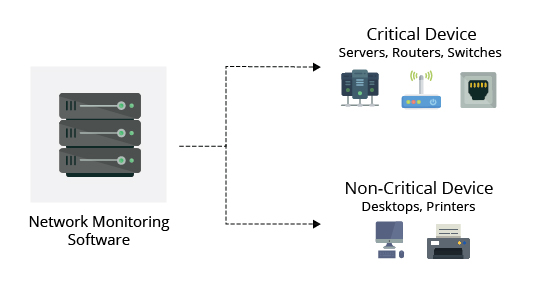Best Practices for Network Monitoring
What is network monitoring?
Network monitoring is a proactive activity carried out by network administrators to ensure that the networks are working optimally by monitoring faults, performance and efficiency of networks. Network monitoring systems include hardware and software tools that are used to monitor aspects of networks like the bandwidth, traffic, uptime as well to check the performance of network devices like firewalls, switches and routers. Network monitoring is important because it can proactively identify faults in networks and prevent network failures and downtimes.
Benefits of network monitoring
There are several key benefits of practicing network monitoring and following the best practices. Some of the main advantages of network monitoring are:
- Network administrators can have a clear picture of the networks and their performance
- Analysis of network components over time helps to identify the needs for upgrades and implementation of new infrasturcture
- Organizations can understand the normal performnace of their networks and can easily notice any threats in case of any abnormal changes in the behavior of networks
- Helps for better use of organizational IT resources and budgets
Best practices of network monitoring
Ensure the monitoring of essentials
Network device faults can drastically affect the performance of a network. Therefore network devices needs to be well monitored to ensure that they are performing as expected. We need to ensure that all essential devices are monitored based on the criticality of each device. Network devices are categorized as critical and non-critical devices and performance metrics for each device is decided for monitoring. Critical devices need frequent monitoring whereas non-critical devices donot require frequent monitoring.
 |
| Devices for monitoring can be catergorized as critical and non-critical dveices(Source:manageengine.com) |
Choosing a secure network management protocol is another good practice in network monitoring to optimize the performance of devices. Simple network management protocol(SNMP) and Internet message control point(IMCP) are 2 commonly used protocols in network monitoring. SNMP is widely used for exchanging and extracting information shared between network devices like routers, switches, WLAN controllers. IMCP is basically used for exchange of information between servers and for error reporting in devices like routers.
Use optimal monitoring interval
Determining the suitable time interval/frequency at which the performance metrics for networks are to be checked is important to ensure that the critical devices are under proper monitoring. The interval depends on the criticality of the device/component and having minimum optimum intervals will help to avoid unnecessary load on monitoring tools.
Ex: CPU usage can be assigned a interval of 5 minutes while disk utilization can be assigned a 15 minute interval.
Knowing the threshold values
As a network administrator it is important to have a good understanding of the normal behavior of the network to recognize any changes from the normal network behaviour. Knowing these baseline behaviours help to set different alerts and notifications which minimizes the possibility of downtimes.
Reporting on each network layer
Networks consist of 07 layers according to the OSI architeture and failures can occure in any of those layers. In network monitoring the best practice is to use tools to monitor all layers and detect problems on each layer. Many network monitoring tools facilitates monitoring of these layers by tracking issues related to application delivery failures, routing, bandwidth usage, hardware failures etc.
Implement proper failover options
Implementing a monitoring stratergy with plans on ensuring high availability is important to prevent any loss of collected data in monitoring due to unexpected failures. Sometimes network slowdowns or failures may result in loss or inaccessibility in monitored data for analysis. Having strong failover plans will avoid this issue.
Follow the escalation matrix
An escalation matrix defines who should be notified on management level for diffenrt types of issues encountered in an organization. Network problems occure when right person is not notified or the responsible people ignore the alerts. Therfore it is essential to establish and follow the escalation matrix specially when there are multiple adiministrators or if the person responsible is not available in any network related issue.
Monitoring network has become an important aspect of managing any IT infrastructure. Network monitoring helps organizations to experience uninterupted functionalities in terms of networks. With the advancement of technology more sophisticated systems and tools are available for monitoring networks. Understanding about best practices on monitoring organization's network components would add aditional advantages on using these tools to secure the assets of the organization.
References:
[1]https://www.cisco.com/c/en/us/solutions/automation/what-is-network-monitoring.html
[2]https://www.manageengine.com/network-monitoring/basics-of-network-monitoring.html
[3]https://www.tek-tools.com/network/network-monitoring-guide-and-tools


Very Informative dilesha.keep writing..Can you give some examples to the popular network monitoring tools ?
ReplyDeleteThank you Suranga!!
DeleteHere is the answer for your question.Network performance monitoring and diagnostic (NPMD) tools are popularly used in organizations to easily handle the network monitoring tasks. These tools help to reduce the burden of challenges faced by network monitoring teams and these tools often provide the diagnostic workflows and forensic data to identify the root causes of performance degradations in networks. Gartner's Market Guide for Network Performance Monitoring and Diagnostics can be a great resource for understanding about profiles of top network performance monitoring vendors. Accedian, AppNeta, Broadcom, Cisco, Colasoft, Entuity, ExtraHop, Flowmon, Kentik, LiveAction, LogicMonitor are some tools highlighted in the Garner's report for 2020.
It is good to read that article Dilesha. Every organization should have a network. So, knowing best practices is essential.
ReplyDeleteThank you Rajitha!!
DeleteClear and to the point. Keep Writing!
ReplyDeleteThank you Kawee!!
DeleteVery interesting article... Good job..
ReplyDeleteThank you!!
Delete